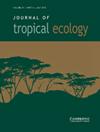某些带状蠕虫(蠕虫门)的倒立行为
IF 1
4区 环境科学与生态学
Q4 ECOLOGY
引用次数: 0
摘要
我们研究了来自越南、菲律宾、澳大利亚和关岛的丝带虫属 Balionemertes 以及来自越南的 Cephalothrix suni。我们的观察结果表明,带状蠕虫主要以腹面向上的方式爬行(腹面是嘴巴张开的地方),这种行为在以前的文献中没有记载。与许多其他有颜色图案的蠕虫物种一样,它们的行为背表面(= Balionemertes 和 C. suni 的解剖腹表面)比另一侧颜色更深和/或图案更密集。在蛭形底栖动物中,这种行为背腹体轴倒置的情况似乎很少见,至少在尼目动物中迄今尚未发现,这可能与它们的摄食策略有关,应在今后的研究中加以观察。本文章由计算机程序翻译,如有差异,请以英文原文为准。
Upside-down behaviour of certain ribbon worms (phylum Nemertea)
Ribbon worms in the genus Balionemertes from Vietnam, the Philippines, Australia, and Guam—as well as Cephalothrix suni from Vietnam—were examined. Our observations indicate that the worms crawl mostly with their ventral surface upwards (the ventral surface being where the mouth opens), a behaviour that has not been documented in previous literature. Like many other worm species with colour patterns, they have a darker-coloured and/or more intensely patterned behavioural dorsal surface (= anatomical ventral surface in Balionemertes and C . suni ) than the other side. This type of behavioural dorsoventral body-axis inversion among vermiform benthos seems to be rare—not having hitherto been known at least in the phylum Nemertea—and may be related to their feeding strategy, which should be observed in future studies.
求助全文
通过发布文献求助,成功后即可免费获取论文全文。
去求助
来源期刊

Journal of Tropical Ecology
环境科学-生态学
CiteScore
2.10
自引率
0.00%
发文量
44
审稿时长
18-36 weeks
期刊介绍:
Journal of Tropical Ecology aims to address topics of general relevance and significance to tropical ecology. This includes sub-disciplines of ecology, such as conservation biology, evolutionary ecology, marine ecology, microbial ecology, molecular ecology, quantitative ecology, etc. Studies in the field of tropical medicine, specifically where it involves ecological surroundings (e.g., zoonotic or vector-borne disease ecology), are also suitable. We also welcome methods papers, provided that the techniques are well-described and are of broad general utility.
Please keep in mind that studies focused on specific geographic regions or on particular taxa will be better suited to more specialist journals. In order to help the editors make their decision, in your cover letter please address the specific hypothesis your study addresses, and how the results will interest the broad field of tropical ecology. While we will consider purely descriptive studies of outstanding general interest, the case for them should be made in the cover letter.
 求助内容:
求助内容: 应助结果提醒方式:
应助结果提醒方式:


